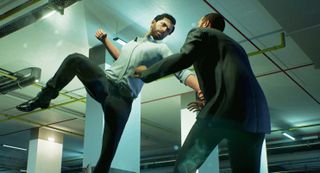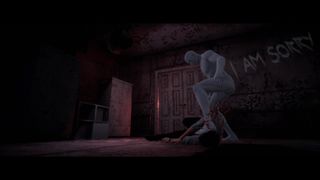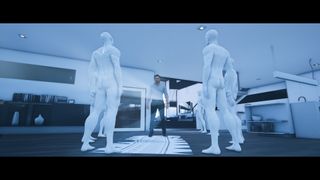Past Cure is a John Wick-inspired psychological action game from a tiny indie team
Stealth, slow-mo pistol shooting, and terrifying prison monsters in this indie action debut.

I miss stylish third-person action games. Even among Steam's 6,000-and-counting new games in 2017, it's hard to find stuff like that reminds you of Max Payne, Syphon Filter, Splinter Cell, or Stranglehold—action games where there's some mixture of pistol work, gadgetry, or supernatural power laid atop a hard-boiled protagonist's contemporary crime story.
As an indie game, Past Cure definitely isn't trying to be the next Max Payne, but it is born out of some of that pleasantly gritty heritage. Its troubled main character, Ian, is a "highly decorated ex-elite soldier" with a three-year gap in his memory. Somewhere between stepping out of a plane in Syria and waking up in England, he gained the ability to slow time and astrally project himself (neat), but also hallucinations and nightmares (bad) that occasionally manifest in reality as ghoulish, humanoid monsters that try to kill him (extremely bad). Grappling with all this, Ian learns early on in the game that someone in England is selling pills that grant the same powers he's gained—the strongest lead so far to finding the people who did this to him.
Ian repairs a power connection in a quick puzzle not dissimilar from BioShock's plumbing minigame.
That premise also expresses Past Cure's mix of genres. From what I was shown of the game this week, Past Cure seems to be treading a line between R-rated action, conspiracy, and moments of psychological fear, but without wading fully into horror. The game's website goes as far as quantifying it: "35% action, 15% stealth, 30% thriller, and 20% horror."
In a parking lot level, I creep between concrete dividers and cars, stealth-killing well-dressed guards on patrol. When I clumsily wandered into one of the guards' vision cones, I ate a hail of bullets before jabbing Ian's time manipulation ability to manage the threat and line up headshots. Later, playing more cautiously, I use astral projection to scout ahead for enemies—the disembodied camera ability operates a bit like Assassin's Creed's eagle vision.
Past Cure's combat isn't highly technical, but there were a couple details I appreciated. When shooting, there's two reticles: one that represents your aim, and one that represents where the barrel of your gun is currently pointed as it moves. Measuring that delay mechanically is something I've only seen in MechWarrior Online and a couple of other simmy shooters, and it's a welcome drop of fidelity. In hand-to-hand fighting, a separate button performs a killing blow at the end of a combo, and another counter-attacks after you take a hit. It's not Tekken, but it's a step up from mashing a single button.

In a later chapter of the game, combat was completely off the table. Ian awakes in a rusted prison cell, a flashlight just out of reach beyond the bars. Eventually breaking out, Ian sees children's crayon drawings hung on the walls of crumbling concrete, the first sign that the prison is not only abandoned, but that some or all of it was in Ian's head. Ian repairs a power connection in a quick puzzle not dissimilar from BioShock's plumbing minigame, and then an alabaster ghoul appears, one of his hallucinations made real.
This scary section was mechanically simple but difficult to pull off—Ian merely has to crouch-walk to avoid the patrolling monster in the prison's kitchen in order to find a key hidden there, but if it sees him, he's dead. I do hope that these hallucinations take some different forms throughout Past Cure's 8-10 hours—I like the horror influence, but the monster essentially amounted to another guard on a path.
The biggest gaming news, reviews and hardware deals
Keep up to date with the most important stories and the best deals, as picked by the PC Gamer team.

Still, as the work of just eight people, Past Cure is an impressive first project. Part of Berlin, Germany-based creator Phantom8's goal is to fit into a gap between triple-A and what we perceive as indie. High-end motion capture and facial modeling techniques, necessary for the cinematics seen in Past Cure's trailers, have become much more affordable and more accessible, managing director Simon Gerdesmann tells me. Gerdesmann himself appears as one of the enemies, and his business partner Roman is the model for the antagonist.
It's an encouraging trend that I hope continues: when larger publishers neglect certain subgenres for extended periods, indies like Chucklefish (Stardew Valley), Ninja Theory (Hellblade, which Past Cure shares a technical pipeline with), and Phantom8 see an opportunity to capitalize on a style of game that millions of people still love. Past Cure will be out February 2 at $30.

Evan's a hardcore FPS enthusiast who joined PC Gamer in 2008. After an era spent publishing reviews, news, and cover features, he now oversees editorial operations for PC Gamer worldwide, including setting policy, training, and editing stories written by the wider team. His most-played FPSes are CS:GO, Team Fortress 2, Team Fortress Classic, Rainbow Six Siege, and Arma 2. His first multiplayer FPS was Quake 2, played on serial LAN in his uncle's basement, the ideal conditions for instilling a lifelong fondness for fragging. Evan also leads production of the PC Gaming Show, the annual E3 showcase event dedicated to PC gaming.
Most Popular

